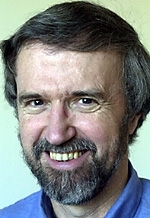This is the fourth in a series on educational initiatives that bring innovation into the classroom.
A leading biologist at MIT is seeking the answer to a major question of our time--is it possible to grab and hold the interest of students in a large lecture class, igniting their curiosity so they want to be there the next time?
To find out, Professor of Biology Graham Walker is taking advantage of the fact that he was named a Howard Hughes Medical Institute Professor last fall (one of just 20 in the United States), an award that comes with a four-year, $1 million grant to to be used for undergraduate education.
Walker, who was one of the first six MacVicar Fellows named in 1992, is also building on his own history of educational innovation at the Institute. He is using the money to staff an "education group" which is organized similarly to his research group. His HHMI education group consists of postdoctoral researchers interested in spending a couple of years in a kind of biology education postdoc position, with graduate students and undergraduate research assistants, all of whom work together to study the problem, come up with curriculum enhancements and evaluate the results.
Walker had already had terrific success getting undergraduates interested in research while teaching advanced research labs for juniors and seniors, and he felt confident about his ability to "get undergrads engaged in the advanced lecture courses," he said. "The opportunity I saw untouched was large lecture classes. I wondered if there was anything I could do that would make lecture classes more exciting, more engaging, cooler."
Walker believes that large lecture courses serve an important purpose--to acquaint large numbers of students with the world-famous scientists who teach at MIT, such as Eric Lander, who Walker calls a "magician" in the classroom. "One concern I have about going to small classes is that only a few lucky kids would get to hear Eric lecture," said Walker, who teaches one of four sections of Introductory Biology, a required subject at MIT.
So he and his "education associates" are making learning in the large classrooms more interactive and relevant. "When they're learning about protein structure, instead of having a diagram on the board, we have it on the screen and twirl it around so they can see the structure from all sides," he said. Instead of looking in a textbook at gel electrophoresis, a basic technology of recombinant DNA, Walker now uses demonstrations where the DNA is run down a gel so that students watch it separate into fragments large and small.
"The Boston Globe continually hands me things on a platter when I teach intro biology," said Walker. "The very same day I was teaching about DNA sequencing, the Boston Globe reported that the SARS virus had been sequenced. Furthermore, that same day came the announcement that the sequence of the human genome was 99.999 percent completed. I tell the students that introductory biology is not like introductory physics or math. Most of that stuff was done a long time ago. Biology is happening now."
A version of this article appeared in MIT Tech Talk on June 12, 2003.






